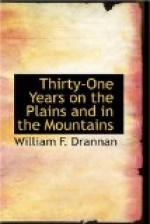White Horse insisted upon our being his guests until morning, it being about noon when we arrived, and as our horses were much jaded we decided to give them the advantage of such a rest.
The Comanche Chief was most exceedingly hospitable, in his way, and would not allow us to eat of our own provisions, but insisted upon our eating with him, and “trotted” out the best “grub” he had.
After breakfast the next morning our horses were brought in by the Indians, who also helped us to pack, and we struck the trail again, accompanied by White Horse and his daughter, who traveled with us all that day and camped with us at night.
That evening Uncle Kit killed a fine buffalo calf, and I thought it the best meat I had ever eaten—even better than dog.
The following morning the Chief and his daughter returned to the village, and we proceeded on our journey.
That day, riding along on my crop-eared pony, about fifty yards behind my companions, I chanced to look behind me and I saw what I thought to be a man, walking on a hill towards us, and he appeared to be at least twenty feet high. As he got further down the hill he appeared to grow shorter, until, I thought, he went down a ravine and out of sight.
I put spurs to Croppy and galloped up to Uncle Kit, and told him I had seen the tallest man on earth, declaring that the man was at least twenty feet high.
“An’ you saw a man that high?” said Uncle Kit
“Indeed I did,” I replied.
“Sure you saw him?” he asked.
“Yes, sir; and if you will watch you will see him come up out of the ravine, directly.”
Uncle Kit, laughing, said: “It was not a man you saw, my boy, but a mirage,” and he explained to me the phenomena, which I became familiar with in the years that followed.
Sometimes the mirages present to the vision what appear to be men, at other times bodies of water surrounded by trees, and often houses and whole towns. They appear before you on the dryest plains and then disappear as if the earth opened and swallowed them.
Early in June we reached Bent’s Fort and met there Col. Bent and his son, Mr. Roubidoux and his son, and a man named James Bridger, of whom you will see a great deal, later on in this narrative. These men were all traders, buying furs and buffalo robes from Indians, white hunters and trappers.
We remained at Bent’s Fort six weeks, and often during that time some one of the many hunters, trappers and traders, that made this place their headquarters, would ask Uncle Kit what he was going to do with that boy—meaning me. To all of which Carson would reply “I’m goin’ to make a hunter and trapper of him.”
During the six weeks at the fort I was out nearly every day with some of the men, and to me they gave the name of “Young Kit.”
By the time we were ready to leave Bent’s Fort, Young Kit became quite a rider, and Uncle Kit had been training me in the dexterous use of the rifle, shooting from my knee, lying on my back, resting the gun on my toes, lying flat on my belly, resting the gun on my hat, and in various other positions.




